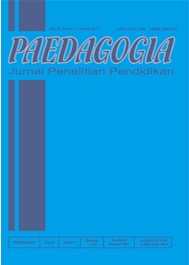Elementary School Students' Problem Solving Strategies in Adding and Subtracting Whole Numbers Through Open Ended Problems
Abstract
Problem-solving skills are an important aspect of mathematics learning that needs to be developed from elementary school. One way to stimulate this ability is through open-ended problems that allow students to express a variety of solution strategies. This study aims to analyze problem-solving strategies and difficulties experienced by grade IV elementary school students in solving story problems of addition and subtraction of whole number with an open approach. The research method used is qualitative with a case study design. The research subjects were grade IV students who were given validated open-ended story questions. Data were collected through learning observation and analyzed descriptively. The results showed that students used different strategies, such as gradually summing, reducing the remaining capacity, and combining the total number with the bus capacity. However, errors in place values, procedural errors, and lack of thoroughness were also found. These findings confirm that open-ended questions are effective in practicing problem-solving as well as exposing students' misconceptions
Keywords
Full Text:
PDFReferences
Aras, L. (2020). Bilangan dan Pembelajaran:Pegangan Bagi Guru dan Calon Guru SD. In Sustainability (Switzerland) (Vol. 11, Issue 1). Pustaka Ramadhani.
Bahar, A., & June Maker, C. (2015). Cognitive backgrounds of problem solving: A comparison of open-ended vs. closed mathematics problems. Eurasia Journal of Mathematics, Science and Technology Education, 11(6), 1531–1546. https://doi.org/10.12973/eurasia.2015.1410a
Becker, J. P., & Shimada, S. (2005). The open-ended approach: A new proposal for teaching mathematics.
Black, P., & Wiliam, D. (2018). Classroom assessment and pedagogy. Assessment in Education: Principles, Policy and Practice, 25(6), 551–575. https://doi.org/10.1080/0969594X.2018.1441807
Bonny, J. W., & Lourenco, S. F. (2013). Achievement : Evidence from the Preschool Years. Journal of Experimental Child Psychology, 114(3), 375–388. https://doi.org/10.1016/j.jecp.2012.09.015.The
Faridah, N., & Aeni, A. N. (2016). Pendekatan Open-Ended Untuk Meningkatkan Kemampuan Berpikir Kreatif Matematis Dan Kepercayaan Diri Siswa. Jurnal Pena Ilmiah, 1(1).
Febriani, R., Syarifuddin, H., & Marlina. (2021). Pengaruh Pendekatan Open - Ended Terhadap Keterampilan Berfikir Kreatif dan Kemampuan Pemecahan Masalah Matematis di Sekolah Dasar. Jurnal Basicedu, 5(5), 749–760.
Freudenthal, H. (1968). Why to teach mathematics so as to be useful. Educational Studies in Mathematics, 1(1), 3–8.
Herman, T. (2010). Aktivitas dalam pembelajaran matematika di sekolah dasar. 4(2), 1–9.
Herzog, M., & Fritz, A. (2022). Place Value Understanding Explains Individual Differences in Writing Numbers in Second and Third Graders But Goes Beyond. Frontiers in Education, 6(January), 1–14. https://doi.org/10.3389/feduc.2021.642153
Jensen, S., Gasteiger, H., & Bruns, J. (2024). Place Value and Regrouping as Helpful Constructs to Diagnose Difficulties in Understanding the Place Value System. Journal Fur Mathematik-Didaktik, 45(2). https://doi.org/10.1007/s13138-024-00234-8
Karlimah, K., Nur, L., & Oktaviyani, H. (2019). Pemahaman konsep operasi hitung penjumlahan bilangan cacah siswa sekolah dasar. Premiere Educandum : Jurnal Pendidikan Dasar Dan Pembelajaran, 9(2), 123. https://doi.org/10.25273/pe.v9i2.4887
Lambert, K., & Moeller, K. (2019). Place-value computation in children with mathematics difficulties. Journal of Experimental Child Psychology, 178, 214–225. https://doi.org/10.1016/j.jecp.2018.09.008
Li, Y., Zhang, M., Chen, Y., Deng, Z., Zhu, X., & Yan, S. (2018). Children’s non-symbolic and symbolic numerical representations and their associations with mathematical ability. Frontiers in Psychology, 9(JUN), 1–10. https://doi.org/10.3389/fpsyg.2018.01035
Liu, J., Sun, M., Dong, Y., Xu, F., Sun, X., & Zhou, Y. (2022). The Mediating Effect of Creativity on the Relationship Between Mathematic Achievement and Programming Self-Efficacy. Frontiers in Psychology, 12(January), 1–10. https://doi.org/10.3389/fpsyg.2021.772093
Nelson, G., & Powell, S. R. (2018). Computation Error Analysis: Students With Mathematics Difficulty Compared To Typically Achieving Students. Assessment for Effective Intervention, 43(3), 144–156. https://doi.org/10.1177/1534508417745627
Putra, A., & Milenia, I. F. (2021). Systematic Literature Review: Media Komik dalam Pembelajaran Matematika. Mathema: Jurnal Pendidikan Matematika, 3(1), 30. https://doi.org/10.33365/jm.v3i1.951
Putrawangsa, S. (2017). Desain Pembelajaran Matematika Realistik. In OSF Preprints (Issue November). CV. Reka KArya Amerta.
Rahmatin, A., & Marzuki, I. (2022). Analisis Kesulitan Belajar Siswa Pada Materi Operasi Hitung Campuran Bilangan Cacah Kelas 3 Sekolah Dasar. EDUSAINTEK: Jurnal Pendidikan, Sains Dan Teknologi, 9(3), 707–722. https://doi.org/10.47668/edusaintek.v9i3.572
Reys, R. E., Rogers, A., Bennett, S., Cooke, A., Robson, K., & Bronwyn, E. (2017). Helping Children Learn. In Helping Children Learn (Second Edi). https://doi.org/10.4324/9781315212517
Rizos, I., & Gkrekas, N. (2023). Incorporating history of mathematics in open-ended problem solving: An empirical study. Eurasia Journal of Mathematics, Science and Technology Education, 19(3). https://doi.org/10.29333/ejmste/13025
Rosanti, A., Tahir, M., & Maulyda, M. A. (2022). Analisis Kesulitan Belajar Matematika Materi Penjumlahan dan Pengurangan Pada Kelas II di SDN 3 Pringgajurang. Jurnal Ilmiah Profesi Pendidikan, 7(3b), 1490–1495. https://doi.org/10.29303/jipp.v7i3b.812
Syarifah, M., & Prabawanto, S. (2023). Strategi Penyelesaian Soal Cerita Siswa Sekolah Dasar: Analisis HambatanBelajar Konsep Penjumlahan dan Pengurangan Bilangan Cacah. Journal of Elementary Education Edisi, 7(1), 2614–1752.
Umayrah, A., Iswara, P. D., Salsabila, S., Azzahra, S. S., & Jeujanan, M. (2024). The Nature of Differentiated Learning in The Perspective of Constructivist Educational Philosophy: A Systematic Literature Review. Jurnal Kependidikan: Jurnal Hasil Penelitian Dan Kajian Kepustakaan Di Bidang Pendidikan, Pengajaran Dan Pembelajaran, 10(2), 691. https://doi.org/10.33394/jk.v10i2.11474
Van de Walle, J. A., Karp, K. S., & Williams, Jennifer M, B. (2016). Elementary and Middle School Mathematics Teaching Developmentally. Pearson Education.
Yeh, C. Y. C., Cheng, H. N. H., Chen, Z. H., Liao, C. C. Y., & Chan, T. W. (2019). Enhancing achievement and interest in mathematics learning through Math-Island. Research and Practice in Technology Enhanced Learning, 14(1). https://doi.org/10.1186/s41039-019-0100-9
Yusri, A. Y., & Sari, M. (2017). Profil Pemahaman Konsep Nilai Tempat Ditinjau Dari Kemampuan Awal Matematika Pada Siswa Kelas III Sdn 133 Takalala Soppeng. Jurnal Mosharafa, 6(2), 141–152.
Refbacks
- There are currently no refbacks.








